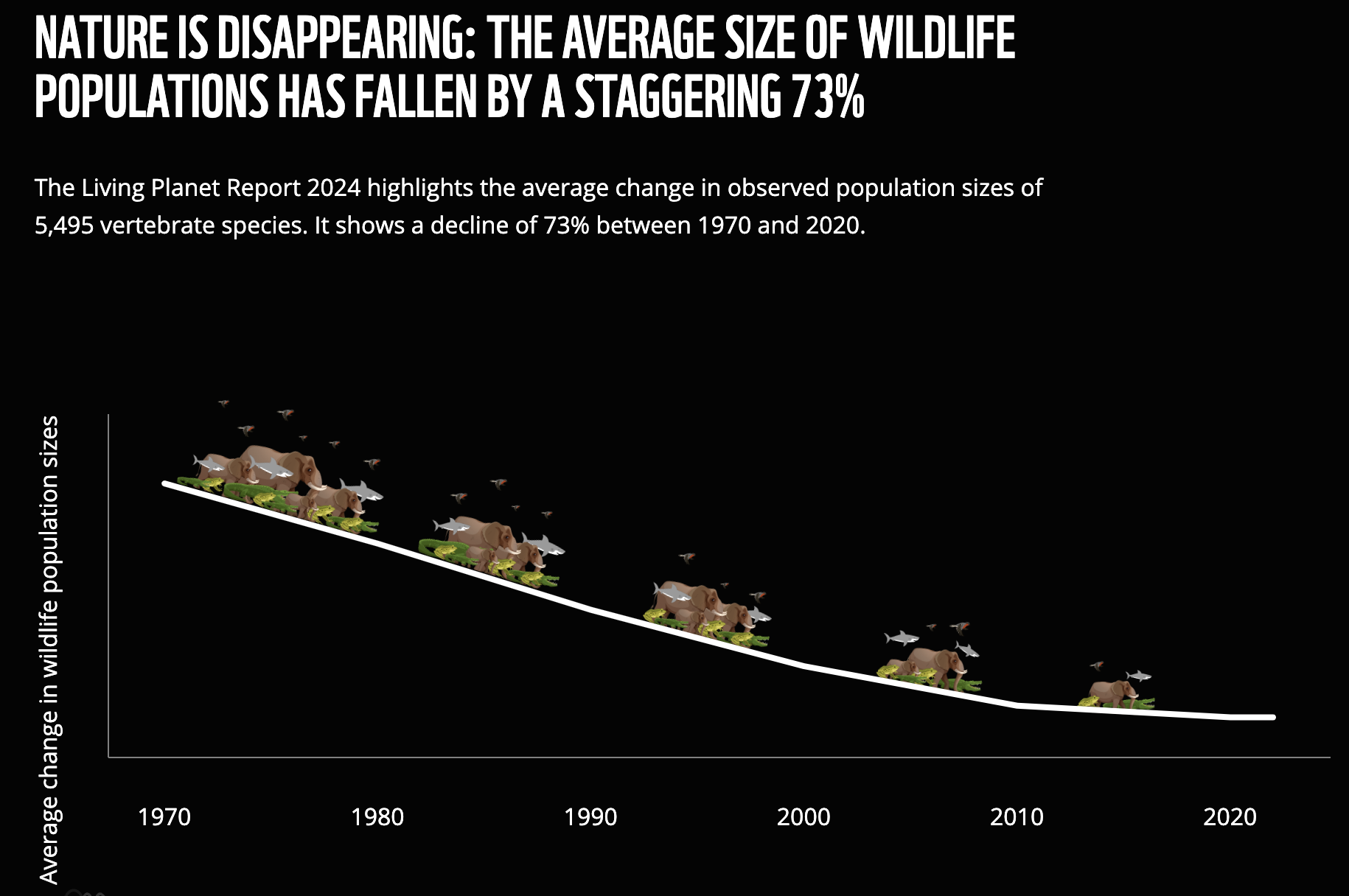

The World Wildlife Fund (WWF) has released its annual Living Planet Report on Oct. 9, revealing an alarming 73 per cent average decline in global wildlife populations from 1970 to 2020.
The report, which analyses global biodiversity trends and planetary health, presented alarming trends as measured by the Living Planet Index (LPI), calculated by the Zoological Society of London (ZSL).
WWF added that "catastrophic consequences" are to be expected if current trends globally are to continue, with dangerous tipping points approaching at local and regional levels.
The report tracks approximately 35,000 population trends across 5,495 species of mammals, birds, amphibians, reptiles and fish populations annually, and is used as an "early warning indicator for extinction risk".
Here are the key findings from the report:
1. 73 per cent decline in the average size of monitored wildlife populations in 50 years (1970-2020)
 Screenshot from The Living Planet Report
Screenshot from The Living Planet Report
Of the monitored wildlife populations, freshwater populations suffered the heaviest decline at 85 per cent.
Terrestrial and marine populations saw a 69 per cent and 56 per cent decline respectively.
2. Latin America and the Caribbean region have the steepest decline in populations
At a regional level, Latin America and the Caribbean have experienced the greatest loss, with a 95 per cent decrease.
Africa has seen a 76 per cent decline, while the Asia-Pacific region recorded a 60 per cent drop.
In contrast, North America (39 per cent) and Europe and Central Asia (35 per cent) have had "less dramatic" declines, albeit still significant.
3. Habitat loss and degradation remain the "most reported threat to wildlife populations globally"
Deforestation and land use changes have led to significant habitat loss and land degradation.
This is primarily driven by our food production systems, notwithstanding other parts of the supply chain process.
Beyond food production, overexploitation, invasive species, climate change and pollution are amongst major factors that have resulted in the decline.
4. More wildlife populations "pushed beyond a critical threshold [...] of irreversible change"
Alongside the LPI, other similar biodiversity indicators suggest that nature is "disappearing at an alarming rate".
More tipping points, which refer to a cumulative point of irreversible change, are to be reached if current trends are left to continue.
Species become increasingly "vulnerable to tipping points" as entire ecosystems are damaged.
For example, experts predict that even if global temperature rise is kept within the 1.5°C limit, an estimated 70 to 90 per cent of all coral reefs globally could still be lost.
This mass die-off of coral reefs would see a loss in habitat and breeding grounds, and upset aquatic ecosystem health.
On a human front, it would destroy fisheries and render hundreds of coastal villages without storm protection.
5. A far cry from achieving 2030 goals
Global agreements, such as the Paris Agreement, and targets such as the 17 Sustainable Development Goals (SDG), have seen countries pledging their commitment but to no avail.
As of 2020, over half of the SDG targets for 2030 will be missed, with 30 per cent of them stalled or worse from the 2015 baseline.
Many national biodiversity strategies and plans across the group are still inadequate and lack the necessary financial and institutional support.
6. Transformation of conservation efforts and the major drivers behind nature loss required
WWF found that conservation efforts, while crucial, must be scaled up significantly to meet the challenges of climate change, biodiversity loss, and ecosystem degradation.
It highlights the need for more integrated and global nature-based solutions, which can potentially help to reduce greenhouse gas emissions whilst benefiting ecosystems and livelihoods.
A transformation of the energy, food, finance systems also underpins the path to a healthier global future:
- Finance: 65 per cent of the world's gross domestic produce is moderately or highly dependent on nature and its services. The report calls for finance to be directed at accounting for the value of nature and addressing nature and climate related risks.
- Energy: Calls for a faster, greener and fairer transformation in the energy sector involves balancing ecosystem needs. The report calls on "careful planning and environmental safeguards" in the implementation of renewable energy mechanisms like hydropower dams.
- Food: Food production accounts for 40 per cent of all habitable land, and is the leading cause of habitat loss. Yet, an estimate of 735 million people still face hunger. Calls for a nature-positive production that meets the needs of people while reducing food loss and waste is needed.
7. Call for countries to "better align their climate, nature and sustainable development policies"
WWF also calls upon countries to implement "more ambitious national nature and climate plans" on both a local and international scale.
The organisation also urges governments to "unlock greater public and private funding to allow action at scale" and to "eliminate activities with negative impacts on biodiversity and climate".
Lastly, it seeks the cooperation of government bodies to "redirect finance away from harmful practices and towards activities that will deliver on the global goals".
Related stories
Top image by Natalie Ong
MORE STORIES



















